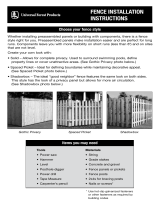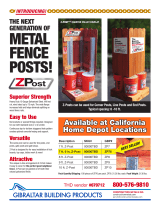
Items you may need
Tools Materials
Power saw String
Hammer Grade stakes
Level Concrete and gravel
Posthole digger Fence panels or pickets
Power drill Fence posts
Tape measure 2x4s for bracing posts
Carpenter’s pencil Nails or screws*
Digging postholes
A general rule of thumb is to place 1/3 of the length of the post
in the ground. Local municipalities may require postholes to be
a specific depth. Please verify code compliance prior to instal-
lation. The fence will be stronger if end, corner and gate posts
are set at least 6" deeper. Using a posthole digger or power
auger, dig the holes 10" to 12" wide and 6" deeper than needed.
Backfill the hole with 6" of gravel to drain water away from the
bottom of the post (Fig. 2). Keep the height of your fence
panels in mind when digging your postholes.
Setting posts
Install end and corner posts first. Tie a string between the posts
along the fence line. This establishes a reference, ensuring the
posts are in line (Fig. 3). Brace the posts using 2x4s nailed to
both the posts and stakes in the ground. This will keep them
straight while the concrete sets. Check for plumb (90º angle)
on two adjacent sides prior to pouring concrete. Fill holes with
ready-mix concrete following the package instructions. Tamp
the concrete to remove any air pockets. Overfill the holes at the
top and slope the concrete away from the post to keep water
from collecting around it. Recheck plumb and alignment of all
posts and allow concrete to cure for 24 to 48 hours.
Cutting the posts to the proper height
An easy method to ensure your post tops are level is to run
a string from corner post to corner post at the desired height,
keeping the string taut (Fig. 3). Mark each post at the string line
and cut off the tops of the posts. Finish off your posts with one
of our decorative finial tops.
Step Method
Parallel Method
Fig. 1
Concrete
6" Gravel
10" - 12"
Fig. 2
Preparation
Check with local ordinances and regulations before building
fences in your area. Before construction, contact your local
utility companies to mark any underground cables and pipe-
lines. In addition, it’s a good idea to discuss plans with any
neighbors along your proposed fence line.
Design and layout
• Determine the number of posts, panels and gates needed
to complete the job, based on total linear footage. Take into
consideration post, panel and gate width when determining
the total number of each.
• Adjust layout to accommodate as many full panels as
possible. If you must use part of a panel, place in farthest
rear corner of the property. Some types of pre-assembled
panels can be trimmed to fit odd-sized layouts, but other
types are difficult or impossible to cut to size.
• Locate property boundaries and drive stakes into the ground
at corners and ends of fence line, 6" inside property boundary.
• Stretch twine or heavy string between stakes and pull tight to
mark layout of fence line.
• Be sure to measure your fence panels and gates prior
to locating the postholes. Also take into consideration
your chosen method of attaching the backer rails to posts
(see Connecting backer rails to posts section). Locate post
placement in the following order along string line:
a) End/corner posts
b) Gate posts
c) Line posts
Installing fences on sloped landscapes
Fences are installed on slopes using one of two methods (Fig.
1). Preassembled panels can only be installed using the step
method. The fence gradually steps up the slope with the rails
level, rather than parallel to the slope.
With loose components, you have the option to use the parallel
method. The rails are installed based on the degree of the slope.
Because this method requires that the fence be constructed
to conform to the slope, it cannot be accomplished using pre-
assembled fence panels.
Planning and Installing Your Fence
WOOD FENCING
10783_9/19
Fig.3
* Use hot-dip galvanized fasteners or other fasteners as
required by building codes.

Installing panels and pickets
When installing panels or pickets, be sure to leave a minimum
2" gap between the ground and the picket bottoms. Pickets
should not touch the ground.
For pre-assembled fence panels, use 18d to 20d nails to attach
them to the posts. If possible, pre-drill holes through the panels
to minimize any splitting from using such a large nail.
To install loose pickets to backer rails, use 8d or 10d box nails.
Start at one end of the rail and check for level and plumb every
three or four pickets. If you wish to build a solid “privacy” fence,
butt the pickets without leaving a gap in between. To build a
spaced picket fence, cut a board the width of the desired gap
and use it as a spacer. Remember to check for plumb every few
pickets. Use three backer rails for fences 6' tall and higher and
two rails for shorter fences. Note: Attach rails 4" from the top
and bottom of pickets to minimize picket movement.
Connecting backer rails to posts
There are many ways to attach backer rails or stringers to the
posts (Fig. 4).
Gate installation
• Determine the swing direction (left- or right-hand open).
• Mount hinge hardware to gate frame at the proper height,
pre-drilling all screw holes.
• Mount gate to gate post, pre-drilling all screw holes.
• Check for full gate swing clearance.
• Mount latch hardware, pre-drilling all screw holes.
Finishing your fence/initial maintenance
Applying a protective finish is recommended to prolong the life
of your fence. The type of finish will be determined by the look
desired and the wood species used. There are three options in
finishing treatments: stain, paint and waterproofing sealer. Clean
your fence with a cleaner/brightener that contains a mildewcide,
prior to applying your finish.
• Stain provides a durable finish coat while maintaining the
natural look of wood. A semitransparent stain is recommend-
ed for new fences. It gives an even appearance and hint of color
while allowing the grain to show through.
• Paint adds color as it protects and seals the fence. The color
can easily be coordinated with your home. Clean, dry and
prime with oil-based primer prior to painting the fence. A
durable exterior latex paint is recommended.
• Waterproofing sealer is best for woods that are not naturally
resistant to decay or are exposed to weather. The sealer helps
prevent rain and moisture from soaking into the wood. Choose
one with a UV stabilizer to slow the discoloration process.
Common maintenance concerns
The continuous changes in weather conditions are extremely
harsh on your fence. Your maintenance plan must be geared
to combat the problems caused by water absorption and water
loss, mildew growth, and discoloration of wood due to the sun's
ultraviolet rays. All of the maintenance concerns discussed
be low are weather-related. The degree to which your fence
is af fected by them depends on many factors. These factors
include general climate conditions (such as normal precipitation,
humidity, etc.) and location in your yard (with regard to direct
sun expo sure, foliage coverage, etc.). If your fence is built using
pressure-treated lumber, it is im portant to note that the pressure
treatment does not increase the likelihood that your fence will
develop these natural defects to any greater degree than the
same material left untreated. These weather-related defects are
beyond the control of the pressure treatment process.
Natural characteristics of wood
We cannot control the occurrence of the natural characteristics
of the wood, which may include raised grain, splitting, warping,
shrinking, swelling or twisting. Continuous water absorption and
water loss in the wood used for your fence will cause its natural
defects to surface. A well-maintained fence will still experience
some of these natural defects. However, the ex tent can be
significantly reduced through a maintenance plan.
To effectively combat these maintenance con cerns, it will be up
to you to follow a preventative maintenance plan.
Your initial maintenance plan should be determined by water
absorption and loss, mildew growth and UV discoloration.
• First-year maintenance: Reapply cleaner/brightener as
described in initial maintenance, and as called for by the
finish of your choice (paint, stain or waterproofing sealer).
• Future periodic preventative maintenance: Depending on the
location of your fence with regard to direct sun exposure,
foliage, coverage, etc., it may be sufficient to clean/brighten
and recoat every two years. A power washer may be
necessary to properly clean your fence.
Planning and Installing Your Fence, continued
Fig.4
Face Nailed
Toe Nailed
Mortise & Tenon
WOOD FENCING
10783_9/19
Place a board under pre-
assembled panels to use as a
lever to adjust the panel to the
proper height on the post. All
backer rails should run the same
measurement to the ground and
to each other on a horizontal
plane, regardless of minor grade
changes. Your finished product
will be much more appealing
to the eye if proper attention is
given to this detail.
-
 1
1
-
 2
2
Ask a question and I''ll find the answer in the document
Finding information in a document is now easier with AI
Related papers
Other documents
-
Unbranded 240396 Installation guide
-
none 162522 Installation guide
-
Unbranded 160278 Installation guide
-
Outdoor Essentials 318731 Operating instructions
-
 Severe Weather 160277 Installation guide
Severe Weather 160277 Installation guide
-
Severe Weather 150919 Installation guide
-
Outdoor Essentials 140114 Installation guide
-
Unbranded 277673 Installation guide
-
Outdoor Essentials 322998 Operating instructions
-
 Z Post ZP76 Specification
Z Post ZP76 Specification



